Top speed 500 km/h Length 14 m First flight August 20, 1969 | Wingspan 14 m Engine type Turboprop Number of seats 2 | |
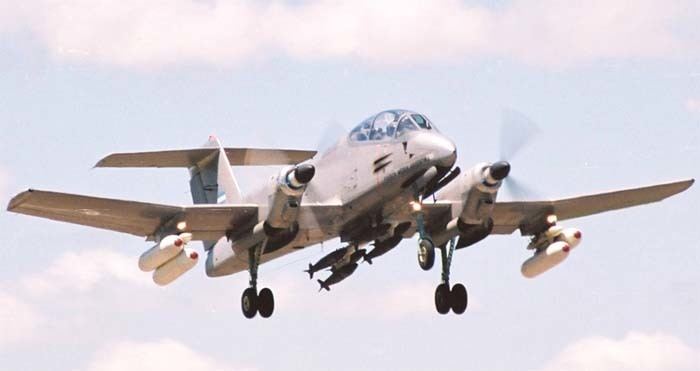 | ||
Manufacturer Fábrica Argentina de Aviones | ||
The FMA IA 58 Pucará (Quechua: Fortress) is an Argentine ground-attack and counter-insurgency (COIN) aircraft manufactured by the Fábrica Militar de Aviones. It is a low-wing twin-turboprop all-metal monoplane with retractable landing gear, capable of operating from unprepared strips when operationally required. The type saw action during the Falklands War and the Sri Lankan Civil War.
Contents
- Development
- Design
- Operational history
- 1982 Falklands war
- Captured aircraft
- Sri Lankan Civil War
- Upgrades
- Variants
- Current operators
- Former operators
- Failed contracts
- Specifications
- References
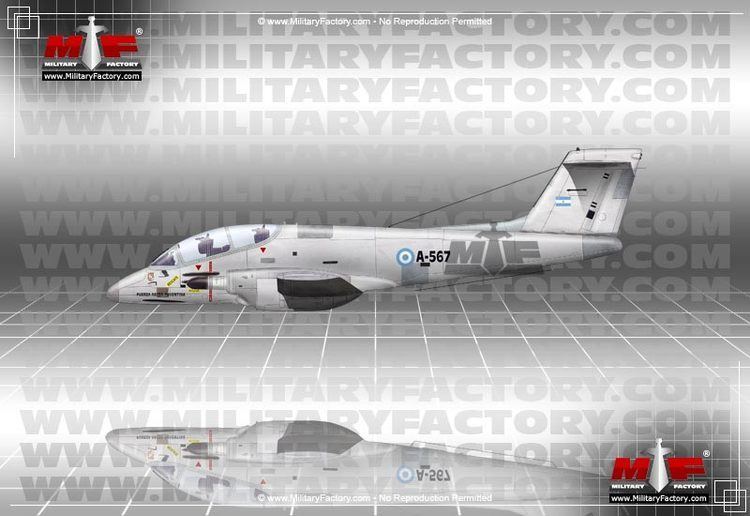
Development
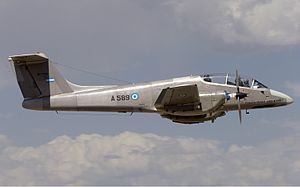
In August 1966, Dirección Nacional de Fabricación e Investigación Aeronáutica (DINFIA), the Argentine state aircraft factory began development of the AX-2, a Counter-insurgency (COIN) aircraft to meet a requirement of the Argentine Air Force. The project was promoted by engineer Ricardo Olmedo and became under the guidance of engineer Aníbal Dreidemie, who also designed the IA-52 Guaraní II and the IA-63 Pampa. The chosen layout was a low-wing monoplane powered by two turboprop engines mounted in wing-mounted nacelles and fitted with a T-tail. In order to test the proposed layout, DINFIA first built a full-scale unpowered glider test vehicle, this flying for the first time on 26 December 1967.
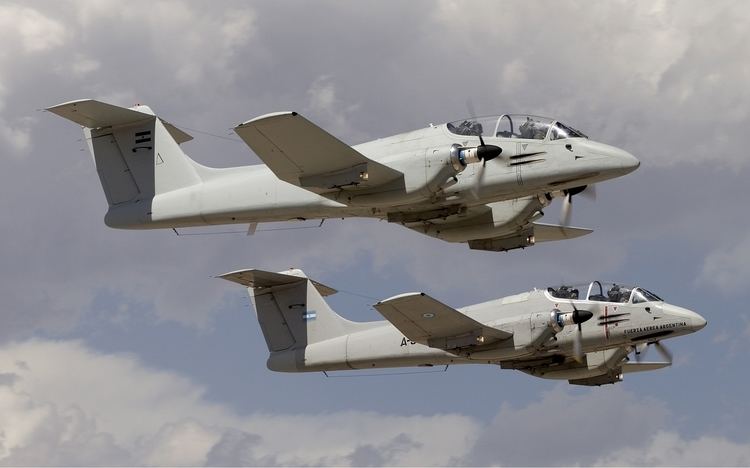
Testing of the glider showed no major handling problems, and in September 1968, construction began on a powered prototype, given the designation FMA IA 58 Delfin, but later renamed Pucará, to be powered by a pair of 674 kilowatts (904 hp) Garrett TPE331I/U-303 engines. (DINFIA had been renamed the Fábrica Militar de Aviones (FMA) earlier that year). The first prototype made its maiden flight on 20 August 1969, with a second prototype, with power switching to 729 kW (978 shp) Turbomeca Astazou XVIGs, following on 6 September 1970. The first prototype was later re-engined with the Astazou, this engine being chosen for the production version, and a third production prototype followed in 1973. The first production model flew on 8 November 1974, with deliveries beginning in early 1976.
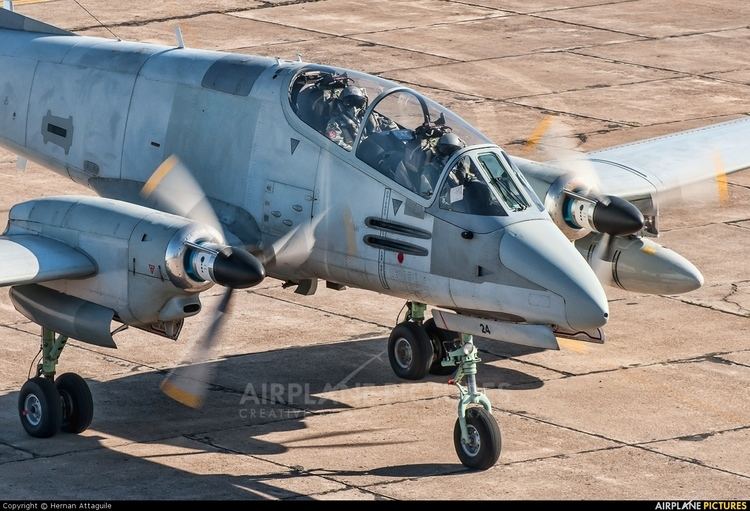
At least three projects were related to the IA-58 development. The first was an extended Pucará airframe with pressurized cabin for six passengers, equipped with Astafan turbofan engines for light transport and photography duties. The second was an observation and reconnaissance aircraft having the same configuration as the Fairchild-Republic A-10. The third was denominated IA-60 and was an advanced trainer and light attack platform powered by two Astafans conserving the basic airframe and canopy of the Pucará with T-tail incorporating high wings. Some tests were made on wind tunnels but no further development was made in order to proceed with the IA-63 Pampa program.
Design
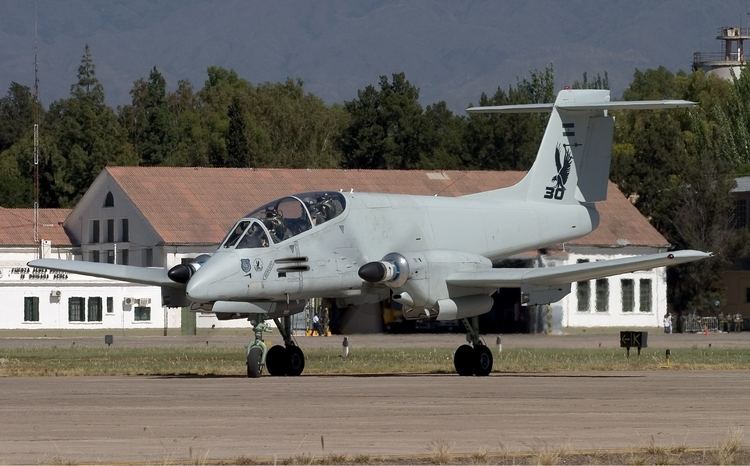
The IA 58 Pucará is of conventional, all-metal (mainly duralumin) construction. The unswept cantilever wings have 7 degrees of dihedral on the outer panels and are fitted with slotted trailing-edge flaps. The IA-58 has a tandem cockpit arrangement; the crew of two is seated under the upward opening clamshell canopy on Martin-Baker Mk 6AP6A zero/zero ejection seats and are provided with dual controls. Armour plating is fitted to protect the crew and engines from ground fire. The aircraft is powered by a pair of Turbomeca Astazou engines, driving sets of three-bladed Ratier-Forest 23LF propellers; the propellers are also capable of being used as air brakes.
The Pucará was designed for operations from short, rough airstrips. The retractable tricycle landing gear, with a single nosewheel and twin mainwheels retracting into the engine nacelles, is fitted with low pressure tyres to suit operations on rough ground, while the undercarriage legs are tall to give good clearance for underslung weapons loads. Three JATO rockets can be fitted under the fuselage to allow extra short takeoffs. Fuel is fed from two fuselage tanks of combined capacity of 800 L (180 imp gal; 210 US gal) and two self-sealing tanks of 460 L (100 imp gal; 120 US gal) in the wings. The undercarriage, flaps and brakes are operated hydraulically, with no pneumatic systems.
Fixed armament of the Pucará consists of two Hispano 804 20 mm cannons mounted under the cockpit with 270 rounds each and four 7.62 mm Browning machine guns mounted on the sides of the fuselage with 900 rounds each. Three hardpoints are fitted for carrying external stores such as bombs, rockets or external fuel tanks, with one of 1,000 kg (2,200 lb) capacity mounted under the fuselage and the remaining two, of 500 kg (1,100 lb) capacity beneath the wings. Total external weapons load is limited to 1,620 kg (3,570 lb). Onboard armaments are aimed by a simple reflector sight.
Operational history
The first units were delivered in May 1975 to the Argentine Air Force (Spanish: Fuerza Aérea Argentina, FAA), equipping the 2° Escuadron de Exploración y Ataque, part of the 3rd Air Brigade (Spanish: III Brigada Aérea) in northern Reconquista, Santa Fe province. They had their operational debut late in 1975, when a number of Pucarás carried out counter-insurgency strikes from Córdoba against Communist ERP guerillas in Tucumán Province as part of Operativo Independencia.
1982 Falklands war
By the time of the Falklands War, about 60 Pucarás had been delivered As one of the few aircraft of the Argentine service capable of flying operationally from the small airfields in the Falklands, as the runway at Port Stanley Airport was not long enough for FAA Skyhawks and Mirages to be deployed, it was decided to deploy a number of Pucarás to the Falklands, with four arriving at Port Stanley on 2 April 1982, with a further eight arriving on 9 April. Many of the Pucarás remaining on the mainland were moved to Puerto Santa Cruz or Comodoro Rivadavia in southern Argentina where they were closer to the Falklands if needed for reinforcements, and were used to perform coastal surveillance.
Most aircraft used in combat were armed with unguided bombs, 2.75 inch rocket pods, or 7.62 mm machine gun pods. Pucarás operated from Port Stanley airport and two small grass improvised airfields at Goose Green and Pebble Island. They were used in the reconnaissance and light-attack role.
Three Pucarás were destroyed and one of their pilots killed at Goose Green by cluster bombs dropped by 800 NAS Sea Harriers on 1 May 1982. Six more were destroyed in the SAS Raid on Pebble Island on 15 May 1982.
On 21 May a Pucará was lost to a Stinger SAM fired by D Squadron SAS (the first Stinger launched in combat) and another to 30 mm cannon rounds from Cmdr Ward's RN Sea Harrier, the latter after leading a successful two-aircraft raid on a shed allegedly used as an observation post by British forces. The aircraft was surprisingly tough, as Ward observed no fewer than 20 cannon hits before the target started to fall to earth. The other Pucará, piloted by Lt. Micheloud, made good its escape after being chased by Lt. Cmdr. Craig's Sea Harrier. Major Tomba, the pilot of the aircraft shot down by Cmdr Ward, survived the ejection and was recovered by friendly forces.
Two Pucarás shot down a Royal Marines Scout helicopter with 7.62 mm machine gun fire on 28 May, while it was on a casualty evacuation mission during the battle of Goose Green. This was the only confirmed Argentine air-to-air victory of the war. One of these Pucarás crashed into Blue Mountain on the return flight to Port Stanley and was destroyed—the body of the pilot (Lt. Gimenez) was found in 1986, and was buried with military honours at Port Darwin by his family, the first Argentine relatives to visit the Falklands since the end of the war.
Also on the 28 May 2 PARA shot down a Pucará with small arms fire after it launched rockets on British troops (without causing any casualties), during the Battle of Goose Green. Lt Cruzado ejected and became a POW.
Captured aircraft
After the Argentine surrender eleven Pucarás (four of them in flying condition) were captured by British forces. Six were taken back to the United Kingdom, as follows:
Sri Lankan Civil War
Four Pucarás were purchased by the Sri Lanka Air Force for counter-insurgency operations from 1993 to 1999. Despite the initial success on the first two years of COIN operations against Tamil rebel forces, the purchase of SA-7 Igla missiles by the latter resulted in destruction of two Pucaras during combat sorties. In July 1995, during fierce fighting in the Northern Province, near Jaffna, Tamil Tiger rebels downed a third Pucará, the pilot Fg Off D. F. D. S. Perera was killed.
Upgrades
In May 1982, at the peak of the Falklands War, the Argentine Air Force, in collaboration with the Navy, outfitted a prototype, AX-04, with pylons to mount Mark 13 torpedoes. The aim was its possible production as torpedo-carrying aircraft to enhance the anti-ship capabilities of the Argentine air forces. Several trials were performed off Puerto Madryn, over Golfo Nuevo, but the war ended before the technicians could evaluate the feasibility of the project.
Several attempts were made to upgrade the entire fleet, including the Pucará Charlie conversion, Pucará 2000 and Pucará Bravo (modernization of 40 units was ordered and later cancelled by the FAA, only one unit was converted). These were cancelled during the 1980s due to shortage of funds.
The Uruguayan Air Force updated its fleet with the incorporation of Litton LTN-211 and GPS omega navigation systems. Minor structure modifications were made in order to carry the Mk. 82 Snakeye bomb and 1000-litre drop tank. Other avionics incorporated were the WX-500 Stormscope by L3 Communications and LED Sandel SN3500 backlit display navigation.
In 2007 an IA-58 of the Fuerza Aérea Argentina was converted to carry a modified engine operating on soy-derived bio-jet fuel. The project, financed and directed by the Argentine Government (Secretaría de Ciencia Tecnología e Innovación Productiva de la Nación), made Argentina the second nation in the world to propel an aircraft with biojet fuel. The project intends to make the FAA less reliant on fossil fuels.
Since 2009 an extensive upgrade of the avionics and major overhaul of the airframes has been carried out by the FAA and FAdeA, creating the IA-58D Pucará Delta. The avionics for the cockpit will be as close as possible to the FMA IA-63 Pampa Phase II. Some of the updated components will include a new set of communications hardware, DME, ELT, IFF, GPS, EADI, EHSI, RWR, HUD, DEFA 554 cannon and new powerplant PT6A-62 950shp instead of the original Turbomeca Astazou. The overhaul will keep Argentinian Pucarás active until 2045. Bureaucratic and economic issues are delaying the conversion of the entire fleet. Fuerza Aerea Uruguaya also showed interest on the maintenance, repair and overhaul (MRO) program and installation of new engines offered by FAdeA.
As of April 2016, Fabrica Militar de Aviones is in the process of modernizing twenty of the Argentine air force’s fleet of Pucaras. The first prototype flew in November 2015.
Variants
Current operators
Former operators
Failed contracts
The first foreign contract was celebrated in February 1978 with the Islamic Air Force of Mauritania for four IA-58A planes plus support and training at a full cost of U$10.8 million. Another eight units were also negotiated as options. When Mauritanian President Moktar Ould Daddah was ousted in a coup d'état, the contract was cancelled. The plane series n°15 and n°018 were built and ready to ship with Mauritanian registration numbers. Then were incorporated to the Argentine Air Force as A-515 and A-518 keeping the desert camouflage and configuration.
In March 1983, negotiations for two Pucarás were going with Central African Empire for US$9.5 million including support, training and spare parts. Contract was cancelled.
In September 1983, another contract was signed, this time with the Venezuelan Air Force for 24 IA-58A equipped with Garrett TPE331-11-601W turboprop engines, at U$110 million. Venezuela cancelled the purchase order. A number of OV-10A Broncos were negotiated and later incorporated from the USAF stocks instead, with credit facilities.
In March 1985, a new contract which was later disbanded due political foreign issues, was signed with Iraq for 20 IA-58A with 20 more on option for U$76 million.
In May 1986 Bolivian Air Force requested 12 IA-58A for U$52 million, with no purchase orders placed.
Iran negotiated 60 IA-58A for U$283 million by April 1987 and at the end of that year a new deal for 50 planes at U$160 million with no purchase orders ever placed.
In November 1987, six Pucarás were negotiated with Force Aérienne Zairoise for US$26.7 million, contract cancelled.
On 1990 Brazilian Air Force announced a purchase of 30 IA-58A as part of the project SIVAM. But with the development of the Embraer EMB 314 Super Tucano, the order was cancelled.
By 1991 a purchase order was negotiated by the Paraguayan Air Force for four IA-58A at U$10.6 million but later disregarded.
Specifications
Data from Jane's Civil and Military Upgrades 1994–95
General characteristics
Performance
Armament
